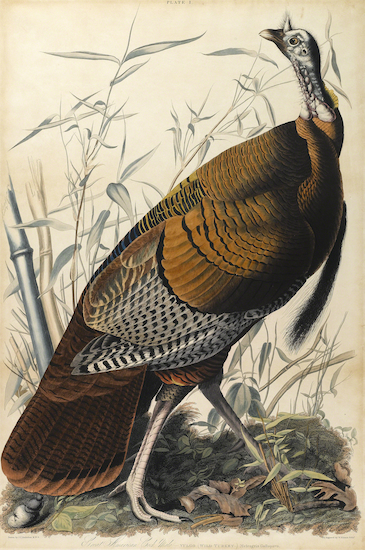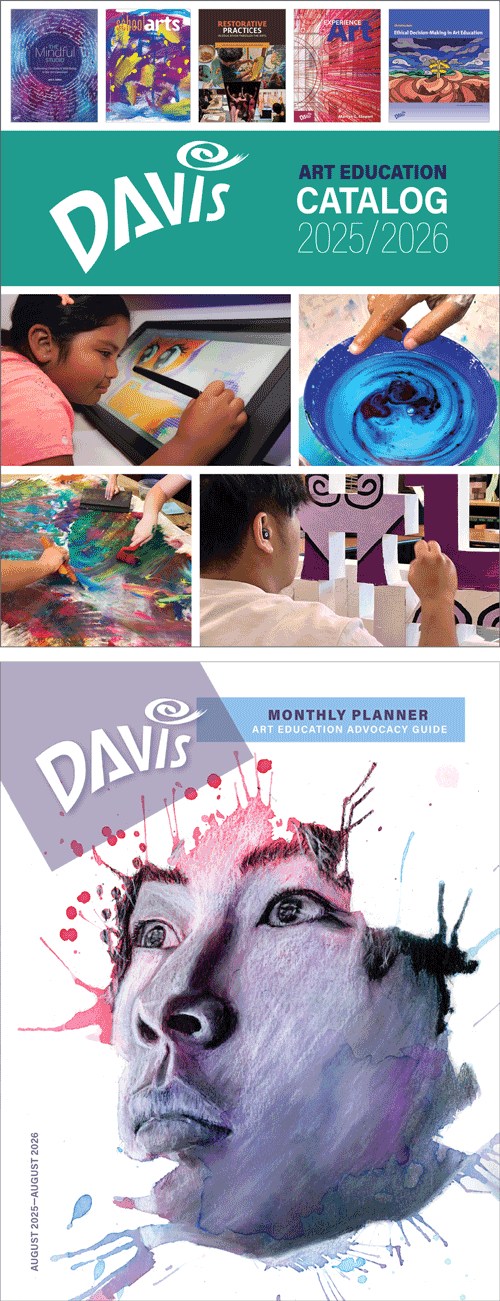Happy Thanksgiving
What is a more common symbol of Thanksgiving than a turkey? It’s an oft-quoted myth that Ben Franklin (1706-1790) wanted the American wild turkey as the bird for the national seal of the US. He simply said in a 1784 letter to his daughter that the turkey was a “more respectable bird (?!)” than the bald eagle.
Happy Thanksgiving 27 November 2025: Art by John James Audubon (1785-1851 US, born Haiti)
 |
| John James Audubon, Wild Turkey, Male, engraved by Robert Havell, Jr (1793-1878), Volume I, plate 1 of The Birds of America, 1835, hand-colored engraving on paper, 101.6 x 68.6 cm © 2025 Brooklyn Museum (BMA-1334) |
The wild turkey was Audubon's favorite bird to illustrate. It is evident from the copious notes he made on the bird from his first edition of the Birds of North America. It was the largest bird species in his publication. The original Havell engravings were produced on double elephant folio paper. That was the largest paper available for printing at the time. The copper plate engravings were based on Audubon's oil paintings in which the subject birds were true to life size. Audubon supervised the reproductions in Havell's London workshop.
Background
As prosperity increased in America during the first half of the 1700s, colonists were able to afford luxury items such as paintings. Also with the increase in prosperity came the desire by affluent people in the colonies to reflect the cultivated taste in painting of their counterparts in Britain. Many painters of the 1700s looked to British artists for influence. Landscape and other subjects dealing with nature did not become significant subject matter until the end of the first quarter of the 1800s. Americans recognized the truly unique nature of the American wilderness and its wild life, and sought to document it in works of fine art.
The revolution in scientific studies engendered during the Enlightenment of the 1700s in Britain and Europe spread to the United States after the American Revolution (1776-1783). In America, as in Europe, art and science often merged. The fashion for expensively produced manuscripts and printed books of a wide range of scientific studies -- from anatomy to botany -- were illustrated by eminent artists, a flowering of which started during the Renaissance (1400-1600).
In America, the interest in ornithology, the study of birds, began early in colonial art with The Natural History of Carolina, Florida and the Bahama Islands, published before the Revolution by the English scientist Mark Catesby (1682-1749). It was the first scientific study of mammals and birds in North America, with engraved, hand-colored plates showing birds in their natural surroundings. Alexander Wilson (1766-1813, born Scotland) published American Ornithology in seven volumes between 1808 and 1813, consisting of hand-colored engravings. His notes often referred to specimens in the museum founded by another brilliant American scientist-artist, Charles Willson Peale (1738-1815). These artists, all schooled in the Enlightenment, set the stage for John James Audubon.
Audubon was born in Haiti and raised in France, where, at an early age, he took an interest in drawing animals and birds. Although nothing is known of his artistic training, he was probably largely self-taught. He emigrated to the US in 1803, probably to avoid proscription into Napoleon's army. He lived first in Philadelphia, and undertook there the first ever American banding of birds to track their migration.
For ten years Audubon traveled the Ohio River as a salesman, drawing birds in his spare time. After opening a failed general store in Henderson, Kentucky in 1819, he devoted himself full time to his passion, documenting the birds of America. He lived a transient life drawing birds until 1826 when he had produced 435 watercolors to form his magnum opus, The Birds of America.
Audubon always drew life-sized watercolors from dead specimens. His format was usually one example of a bird in profile, set in a background that he had thoroughly researched, often having done studies of the surrounding flora. This differed from Wilson's studies that were set on blank pages. Audubon's original studies were done in watercolor, pastel, or pencil and gouache. He devised early on a method for standing the dead bird upright with a wire grid. In 1826, having secured enough funding from philanthropists in Philadelphia and New York, ripe for the project at the height of the Romantic period, Audubon sailed to England to publish the gigantic project.
The first publication of the 435 hand-colored engravings was issued in series of five prints to subscribers between 1827 and 1838 (the Havell Edition). The total collection was ultimately published in four volumes in a total publication of only 180 editions.
Correlations to Davis programs: Explorations in Art 1E, 4th Grade, Unit 4, Meet John James Audubon; A Personal Journey 2E, Unit 5.1

Comments